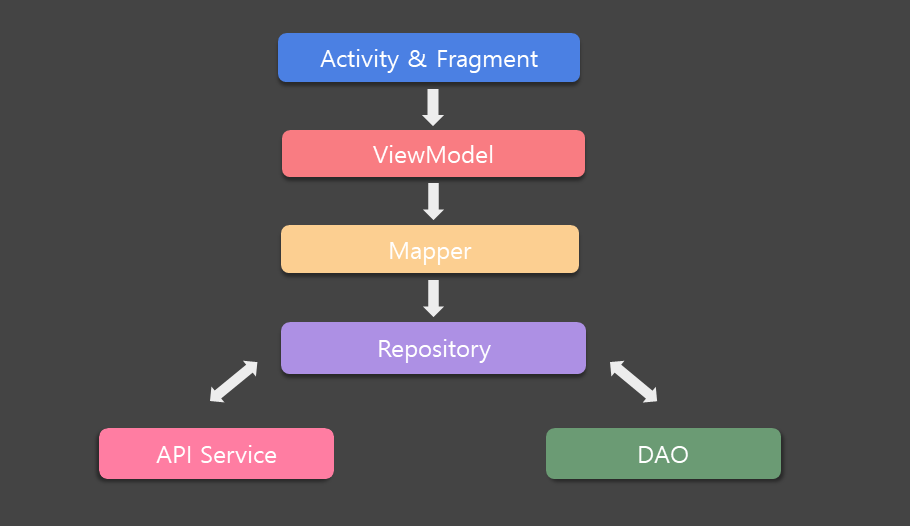Mobile Assignment CS
I have built this application in clean architecture and MVVM presentation archticture. It's well tested and documented for all layers data, domain, and presentation.
How to build it on your environment?
For secutity wise, I have hidden my API key from the project and added it in local.properties
In order to build the project properly in your machince, you have to add your The Movie DB's API key in your local.properties file.
API_KEY="YOUR_API_KEY"
App architecture
Decisions
- Used TDD approach while implementing the project
- Implemented 2 extra gradle files to organize dependencies versions and groups.
- Implemented Detct tool to make static analysis and generates reports in
/app/build/reports/detekt/detekt.html - Created gradle task to read my API key from local.properties -Created two build varients one for release and second for debug to see http logs
- Implemented mappers to map data between the layers
- Provided error handling in data layer to detect 2 kinds of errors
- Server Error : it happens if the server is not responded
- Data Error : if there is an error in the response
- Provided error handling for presentationlayer through modelView, it acts as a state with
- isLoading : to show progressbar while data is laoding
- errorMessage : to show the error message that happened in the data layer
- isEmpty : to show that data is empty and there no thing to be shown
- object data : that's the real data that would be shown
- Used Either concept to perform these error handlings
- Created separated packages and modules to avoid coupling issue and achieve the Separation of Concerns (SOC) concept
- Core package that contains some base and common classes, DI, failure exceptions, and retrofit interceptor
- Features package that contains the clean architecture layers (data - domain - presentation) for each screen
- Used LivDataUtilTest to await the still get the observed data in testing
- Used Mockk for mocking data
- Used Truth for testing assertions
- Used Glide to do caching of loaded images and verified if there is no photo collected, it shows not_found placeholder image
- Used coroutine and flow to use dispatchers for calling endpoints and emit data to other layers and created it in baseUseCase
- Used view binding and data binding to update the views like bindingPosterUrl
- Created animated and custmized RatingView using basic RectF and paints
- Implemented some styles to make it easier to use them in header, and title text..etc
- Used android chips to publish genres in details screen
- Used the excat fonts that used in the design which are helveticaneuelt and helveticaneuelt bold
- I have created some branches in gitlab for each feature and merge each one into develop branch
Assumptions
- I couldn't extract icons in SVG files so I did web inspections to get the logo and also I used extrnal back button icon
- In popular endpoint, there is no attribute for movie duration, So I ignored it
- I tried to follow the deign as much as possiple but there are some missing stuff
Liberaries
- Jetpack
- Viewmodel - Manage UI related data in a lifecycle conscious way and act as a channel between use cases and UI.
- Data Binding - support library that allows binding of UI components in layouts to data sources, binds character details and search results to UI.
- LiveData - Provides an observable data holder class.
- Navigation - navigates between fragments
- Retrofit - type safe http client and supports coroutines out of the box.
- Moshi - JSON Parser, used to parse requests on the data layer for Entities and understands Kotlin non-nullable and default parameters.
- okhttp-logging-interceptor - logs HTTP request and response data.
- kotlinx.coroutines - Library Support for coroutines. I used this for asynchronous programming in order to obtain data from the network as well as the database.
- materialDesign - Use some stuff from material design like Chips
- glide - display and cache loaded images
- paginator - add pagination to recyclerview
- Hilt - Dependency injection plays a central role in the architectural pattern used. For this reason I have chosen Hilt which is built on top of the battle tested DI framework - Dagger 2.
- JUnit - This was used for unit testing the repository, the use cases and the ViewModels.
- Mockk This is a mocking library for Kotlin. I used it to provide test doubles during testing.
- Truth - Assertions Library, provides readability as far as assertions are concerned.
- Robolectric - Unit test on android framework.
- detek - static analysis tool.





